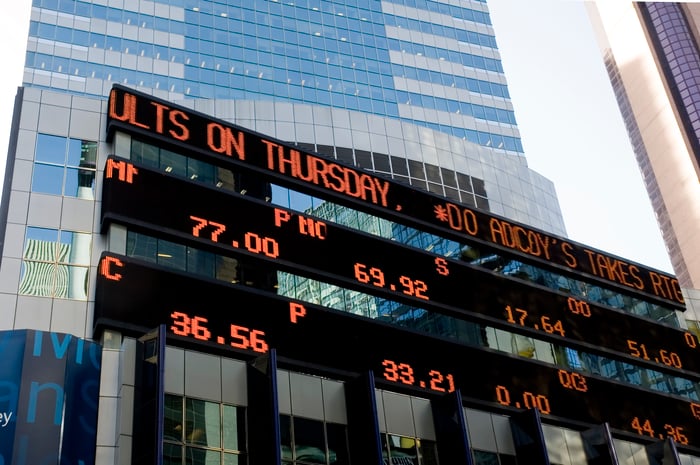This has been one of the most difficult years on record for Wall Street and the investing community. The U.S. economy has delivered back-to-back quarters of gross domestic product declines, the U.S. inflation rate is hitting a more than four-decade high, and Russia's invasion of Ukraine throws an even bigger monkey wrench into an already-damaged global energy supply chain. Perhaps it's no surprise that the benchmark S&P 500 and growth-driven Nasdaq Composite entered bear market territory.
However, the iconic Dow Jones Industrial Average (^DJI -0.03%) has avoided this fate. The Dow Jones, which is comprised of 30 multinational companies, has likely outperformed the other major indexes because it's packed with profitable, time-tested businesses. In other words, sometimes it pays to invest in mature stocks that just keep winning over time.

Image source: Getty Images.
With the broader market taking it on the chin, now is as good a time as any for opportunistic investors to put their money to work. What follows are three Dow stocks that are nothing short of screaming buys in September.
1. Intel
The first Dow stock that's begging to be bought by long-term investors in September is semiconductor stock Intel (INTC 3.17%).
Shares of Intel have been halved over the past 18 months. This looks to be due to a combination of the U.S. and global economy weakening, demand for personal computers declining as workers get back to the office, and supply chain concerns continuing to weigh on production. It also hasn't helped that rival Advanced Micro Devices has been chipping away at Intel's market share in its computing and data center segments.
Yet, in spite of these challenges, buying Intel at its current share price looks like an absolute steal for investors who can exercise patience -- and who want to receive a 4.4% annual dividend yield while they wait for Intel's catalysts to carry shares notably higher.
Before writing Intel's eulogy, skeptics should take a closer look at desktop, mobile, and server market share among central processing unit (CPU) developers and manufacturers. As of the end of the first quarter of 2022, Intel respectively controlled almost 82% of desktop CPUs, close to 78% of mobile CPU share, and just over 88% of server CPU share (excluding Internet of Things devices). It doesn't appear that Intel will be losing its high-margin, cash-rich crown anytime soon.
Another reason to be optimistic about Intel is the expected spinoff of autonomous vehicle company Mobileye, which Intel purchased for $15.3 billion in 2017. Mobileye generated record sales of $460 million during the June-ended quarter, which represents an increase of 41% from the prior-year period. With innovation being the name of the game in the auto industry, it's possible Intel's stake in Mobileye could create a nice windfall for the company.
The $52 billion CHIPS Act, which President Joe Biden signed into law less than a month ago, is an additional catalyst that favors Intel's growth prospects. With subsidies likely on the way to promote manufacturing expansion, Intel is a good bet to reignite its growth engine sooner than later.
Visa
The second Dow Jones Industrial Average stock that presents as a screaming buy in September is payment processor Visa (V -0.25%).
Virtually all financial stocks, including Visa, are cyclical. This is a fancy way of saying that they ebb and flow with the U.S. and/or global economy. If the economy is firing on all cylinders and growing, Visa's top line should expand as consumers and businesses increase their spending. Conversely, when economic contractions and recessions arise, spending tends to decline, which can adversely impact Visa's revenue and profits.
However, it's important to realize that this is a simple numbers game that strongly favors Visa and its patient shareholders. Even though recessions are an inevitable part of the economic cycle, periods of expansion last substantially longer. Simply buying and holding Visa stock should allow investors to take advantage of these disproportionately long periods of expansion.
On a more company-specific level, Visa finds itself as the leading payment processor in the No. 1 market for consumption in the world: the United States. As of 2020, based on filings with the Securities and Exchange Commission among the four biggest payment processors, Visa controlled a 54% share of credit card network payment volume in the United States. Further, no payment processor grew its share of credit card network payment volume more following the Great Recession (2007-2009) than Visa.
Then again, there's plenty of opportunity beyond domestic borders. Visa has demonstrated a willingness to grow inorganically (e.g., the company acquired Visa Europe in 2016) and has plenty of runway to push its payment infrastructure into chronically underbanked regions, such as the Middle East, Africa, and Southeastern Asia.
Lastly, investors should note that Visa strictly acts as a payment processor and completely avoids lending. Though it wouldn't have any issue generating net-interest income and fees as a lender, Visa's management realizes that lending would expose the company to potential loan delinquencies and charge-offs during recessions. Not having to set aside capital to cover loan losses is a big advantage for Visa that allows it to maintain a profit margin above 50%, as well as bounce back from recessions faster than other financial stocks.

Image source: Getty Images.
Verizon Communications
The third Dow Jones stock that's a screaming buy in September is telecom giant Verizon Communications (VZ 0.22%). Whereas Intel is hitting fresh five-year lows, Verizon's share price is flirting with its lowest point over the trailing decade.
A number of factors are weighing on Verizon, including increased promotional activity from its peers, the aforementioned weakening U.S. economic outlook, and rapidly rising interest rates. Verizon, which is known to finance infrastructure upgrades and purchases with debt, will have to pay more to finance future deals and projects. Yet even with these plain-as-day headwinds, Verizon looks like an incredible bargain.
Following years without a true catalyst, Verizon should benefit nicely from the 5G revolution. Although the company will spend billions of dollars to upgrade its wireless infrastructure to support 5G download speeds, it'll be well worth it. Consumers and businesses are expected to upgrade their devices to take advantage of faster download speeds through at least the midpoint of the decade. Since data consumption is what fuels the juiciest margins for Verizon's wireless segment, 5G should steadily move its profit needle higher.
To add to the above, increased competition isn't having a notably adverse impact on the company's core operating segment. The June-ended quarter saw retail postpaid wireless churn hit 1.03%, which is historically low. What this figure tells investors is that Verizon's operating cash flow remains highly predictable, and the company's customers are generally loyal to the brand.
Investors would be wise not to overlook Verizon's 5G at-home broadband push, either. Verizon spared no expense to scoop up 5G mid-band spectrum that it plans to use to reach 50 million households and 14 million businesses with its broadband services by the end of 2025. While broadband isn't the growth story it once was, it can help Verizon boost its operating cash flow and lead to higher-margin media bundles at the consumer level.
With Verizon valued at just eight times Wall Street's forecast earnings for 2023 and doling out a nearly 6% yield, there looks to be a very favorable risk-versus-reward ratio for income-and-value-seeking investors.





